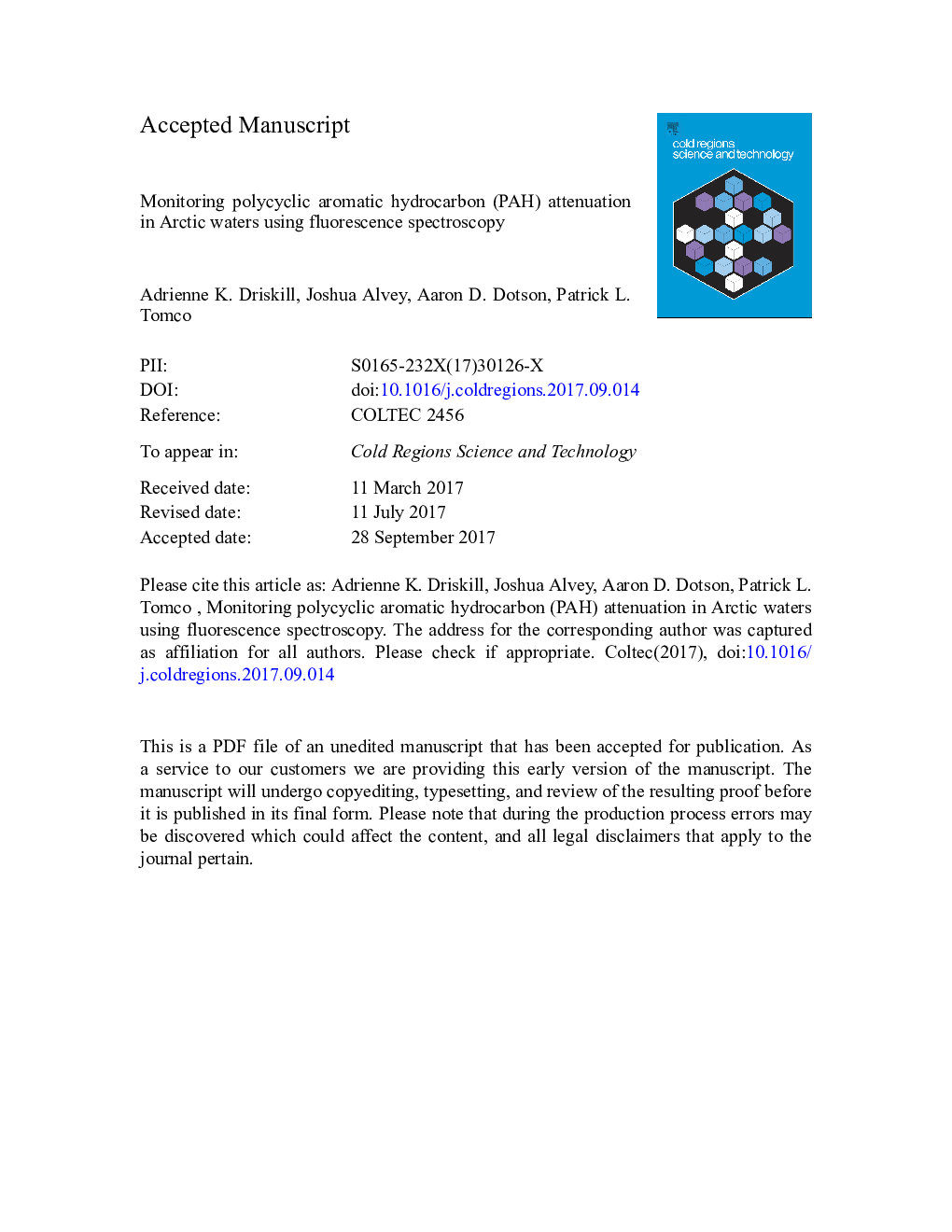| کد مقاله | کد نشریه | سال انتشار | مقاله انگلیسی | نسخه تمام متن |
|---|---|---|---|---|
| 5779325 | 1634419 | 2018 | 38 صفحه PDF | دانلود رایگان |
عنوان انگلیسی مقاله ISI
Monitoring polycyclic aromatic hydrocarbon (PAH) attenuation in Arctic waters using fluorescence spectroscopy
دانلود مقاله + سفارش ترجمه
دانلود مقاله ISI انگلیسی
رایگان برای ایرانیان
کلمات کلیدی
موضوعات مرتبط
مهندسی و علوم پایه
علوم زمین و سیارات
علوم زمین و سیاره ای (عمومی)
پیش نمایش صفحه اول مقاله

چکیده انگلیسی
As oil exploration in the Arctic grows, the risk of crude oil exposure to the environment through spills and leakage increases. Polycyclic aromatic hydrocarbons (PAHs) are a toxic component of crude oil that are highly insoluble and persist in the environment. Much is known about PAH degradation through abiotic and biotic factors and remediation strategies in temperate climates; however, little is known about the degradation of these compounds in the Arctic where cold temperatures and sea ice predominate and remediation strategies differ greatly. In this study, excitation-emission matrix (EEM) fluorescence spectroscopy was used along with parallel factor analysis (PARAFAC) to analyze concentrations of PAHs, associated hydroxylated metabolites, and microbial biomass (as based on the protein-like indicators: tryptophan and tyrosine) in surrogate solutions to develop a correlation between PAH biodegradation and native microbial growth. EEMs generated from solutions of 16 EPA-listed priority pollutant PAHs, metabolites, tryptophan, and tyrosine were characterized. Based on maximum emission wavelength peak intensity (EMλmax), PAHs were found to best categorically group, in an effort to determine which PAHs would serve as effective indicators in comparison to bioindicators (microbial fluorescence-absorbing proteins, smaller labile PAHs, and hydroxyl-PAHs), when EEMs were divided into two regions at EM = 400 nm for all excitation wavelengths, establishing a line of division within the matrix to minimize spectral overlap between indicator groups. Five high molecular weight PAHs (benzo(b)fluoranthene, benzo(k)fluoranthene, fluoranthene, benzo(ghi)perylene, and indeno(1,2,3-cd)pyrene) exhibited peak fluorescence intensities above EM = 400 nm allowing them to serve as PAH indicators while bioindicators presented near or below the line of division. A microcosm batch-incubation experiment, consisting of two PAH treatment groups and a control, demonstrated degradation/dissipation of the high molecular weight PAHs (p < 0.05). A half-life of 128 d was derived for the PAH group treated with a solution of the five high molecular weight PAHs (C0 = 512 μg/L) and 31 d for a treatment of only fluoranthene (C0 = 96 μg/L). A three component PARAFAC model containing incubation samples and aqueous standards accounted for 98.8% variance. The combination of EEM fluorescence spectroscopy and multivariate analysis provides a valuable method for modeling degradation studies and monitoring PAH concentrations and microbial growth under Arctic conditions.
ناشر
Database: Elsevier - ScienceDirect (ساینس دایرکت)
Journal: Cold Regions Science and Technology - Volume 145, January 2018, Pages 76-85
Journal: Cold Regions Science and Technology - Volume 145, January 2018, Pages 76-85
نویسندگان
Adrienne K. Driskill, Joshua Alvey, Aaron D. Dotson, Patrick L. Tomco,